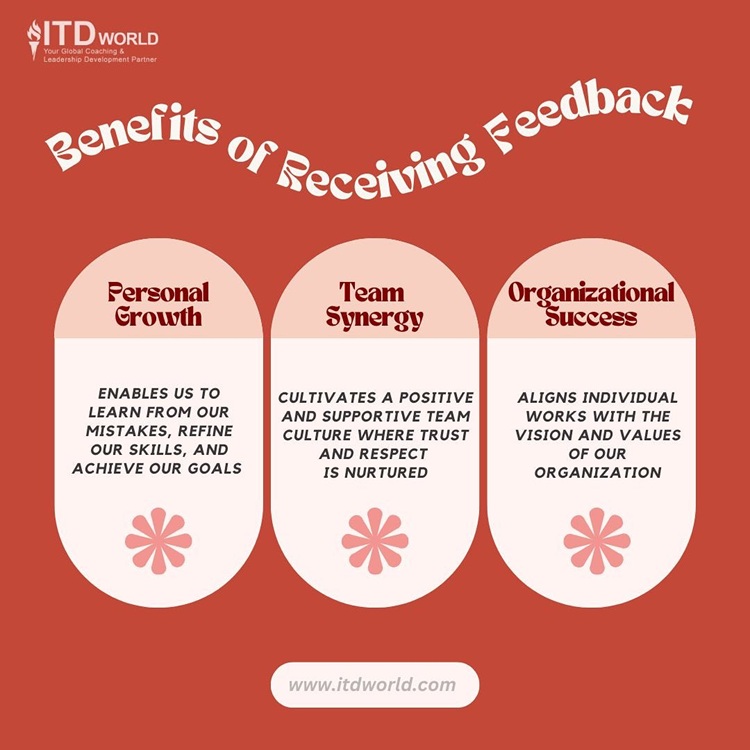This article explores the art of receiving feedback, plus tips strategies to help navigate the process for self-improvement and success.
Receiving feedback is an essential skill for propelling personal and professional growth. Whether it’s in the workplace or in personal lives, feedback provides invaluable insights and opportunities for improvement.
(by Jonathan M. Pham)
Highlights
- Receiving feedback is important as it provides insights for improvement, fosters well-being and innovation, builds trust and rapport, clarifies purpose, boosts motivation and growth, enhances performance, promotes a learning culture, increases employee engagement, and solidifies relationships.
- Despite the challenges, one may get better at receiving feedback by proactively reaching out to others, being receptive, embracing growth opportunities, and practicing accountability.
- To manage emotions when receiving input from others, try to express gratitude, cultivate a growth mindset, pause before responding, consider the source, and seek clarification if necessary.
- To effectively ask for and receive feedback in the workplace, it is recommended that one has a go-to question, embraces the other person’s discomfort, listens to understand, and makes their attention tangible.
Why is Receiving Feedback Important?
- Constant insights
Feedback is an omnipresent force, flowing from our actions, results, and interactions with others. It serves as a potent source of learning, enabling us to gain insights from others and refine our performance as a result. Regardless of whether solicited or unsolicited, input from everyone around us holds the potential to guide us toward improvement.
- Increased wellbeing
Receiving feedback provides the chance for individuals to gain a more comprehensive understanding of their own strengths and areas for improvement. Addressing these aspects is crucial to experiencing personal growth and a sense of accomplishment, leading to increased happiness in life.
- Unlocked innovation
Input from other people often brings forth fresh ideas, perspectives, and insights that can stimulate innovation. By actively seeking feedback, individuals can uncover new approaches and solutions, sparking creativity and pushing boundaries.
- Trust and rapport
When we engage in the exchange of feedback, we demonstrate genuine concern for others and their work. This powerful act of active listening fosters trust and rapport, laying the foundation for stronger relationships and collaboration.
- Sense of purpose
Feedback helps individuals gain clarity about their roles, responsibilities, and contributions. Understanding how their work aligns with the larger goals and objectives of the organization provides a sense of purpose, driving motivation and engagement.
- Motivation and growth
Positive feedback acts as a confidence booster, nurturing self-esteem and empowering us to excel further. Constructive criticism, on the other hand, equips us with the tools to overcome challenges, learn from our mistakes, and evolve. By leveraging feedback, we can set goals, monitor progress, and embark on a transformative journey toward improvement.
- Enhanced performance
Through targeted suggestions, we are provided with the necessary clarity to enhance our performance – and align our work with the expectations and standards of others.
- A culture of learning
Feedback serves as a conduit for ongoing growth – by equipping us with new skills, expanding our knowledge, and cultivating fresh perspectives. In an organizational setting, feedback nurtures a coaching culture that promotes continuous learning and innovation, bringing about an environment that thrives on the power of feedback loops.
When team members feel heard and valued, they are more likely to be engaged, invested in their work, and contribute their best efforts to the organization.
- Solidified relationships
Feedback encourages open dialogue, builds trust, and promotes collaboration, leading to stronger and more productive working relationships. As a result, individuals establish stronger connections with their colleagues, managers, and team members.
Benefits of Receiving Feedback

- For personal growth
Feedback enables us to learn from our mistakes, refine our skills, and achieve our goals. It illuminates areas of development that may have remained hidden, helping us navigate uncharted territories and discover new opportunities.
- For team synergy
Feedback provides a platform for understanding diverse perspectives, facilitating open communication, and resolving conflicts. As such, we may gain insight into the needs and aspirations of our teammates, enabling us to work cohesively towards shared objectives. Not to mention, it also cultivates a positive and supportive team culture, where trust and respect flourish.
- For organizational success
Feedback plays a pivotal role in aligning individual work with the vision and values of the organization. It ensures that our efforts are directed toward meeting the expectations and requirements of the customers and stakeholders. By actively seeking and embracing feedback, we become catalysts for innovation, driving collective success.
The Joy of Getting Feedback – TED Talk by Joe Hirsch
How to Get Better at Receiving Feedback
-
Be proactive
Actively soliciting feedback on a regular basis showcases eagerness to learn and grow. By initiating such conversations, you demonstrate a proactive approach to self-improvement, while also reducing the element of surprise and anxiety that can accompany unsolicited input.
When approaching your colleagues/ supervisors/ mentors to ask for advice, one good way to start the discussion could be something like: “I value your perspective and would appreciate any idea you might have on my recent project. I’m always looking for ways to improve and grow.”
-
Be receptive
When receiving feedback, make sure to adopt an open mindset – while doing your best to understand the other party’s perspectives/ intentions. Give your full attention to the feedback giver, and refrain from interrupting or arguing. A receptive attitude creates a safe space for open and honest dialogue, fostering trust and collaboration.
As human beings, it is completely natural to have emotional reactions, especially when faced with critical or unexpected opinions. However, we all must learn to manage this innate tendency – and refrain from becoming defensive or argumentative. Take a deep breath, maintain composure, and remind yourself to listen and understand before responding.
Read more: Intent vs Impact in the Workplace – How to Close the Gap
-
Reflect and process
Take the time to process the input before responding. Impulsive or emotional reactions only cloud your judgment. Step back, calm yourself, and reflect on what the other person has just communicated objectively. Consider its validity, relevance, and potential usefulness in your personal and professional growth.
Now, let’s say you receive feedback from your supervisor during a performance review. They mention that your communication with team members could be more effective. Instead of immediately reacting defensively or feeling discouraged, take a step back and give yourself some time to process what the supervisor has just said.
You might spend some time asking yourself questions such as:
- What specific instances or situations might have led to this feedback?
- Are there any patterns or recurring issues in my communication style?
- How does this feedback align with my own self-assessment of my communication skills?
- What specific changes or improvements can I make to enhance my communication with others?
- etc.
During this reflection phase, try to approach the advice objectively, focusing on the message rather than any emotional reactions that may arise. After all, the other person is meant to help you grow and improve, and that their input presents a precious opportunity for positive change.
Read more: Emotional Intelligence (EQ) – How to Harness Its Power
-
Embrace growth opportunities
Identify the areas for improvement highlighted in the feedback and determine the actionable steps you can take to address them. Be proactive in seeking additional guidance or resources that can support your growth journey. Implement the feedback into your actions and track your progress along the way.
Let’s get back to the example above. While contemplating your supervisor’s comments, think about the validity and relevance of their input. Are there points that resonate with your own observations or feedback you’ve received in the past? Think about how the advice aligns with your personal and professional goals. Are there areas where you can see potential improvement?
Once enough time has been spent on processing the feedback, you are ready to respond thoughtfully. You might schedule a follow-up conversation with your supervisor to discuss your reflections – as well as share your action plan for addressing their input. This demonstrates your commitment to growth – while also fostering open communication and collaboration.
Read more: Thoughtful Leadership – Why It Matters in Today’s Hectic World
-
Practice accountability and resilience
Accountability means the ability to take ownership of your mistakes and setbacks. Rather than dwelling on past errors, refusing to apologize, blaming others, or making excuses for your shortcomings, it is essential that you acknowledge your missteps, apologize if necessary, and shift the focus towards finding solutions.
Read more: 5Cs of Effective Accountability Partners

Managing Emotions When Receiving Feedback
Begin by thanking the other person for their efforts and insights. You could say something like, “Thank you for sharing. I value your idea and would like to understand it better.” By expressing gratitude, not only are you “breaking the ice” in the conversation, but you are also reminding yourself that the giver is there to help you grow – and no matter how uncomfortable you are with what they have to say, there is always value to gain from it.
- Cultivate a growth mindset
Instead of taking feedback personally or feeling attacked, think of it as an invaluable chance for learning. After all, others’ input is not a reflection of your worth or character, but an opportunity for positive change.
- Pause before responding
Take a moment to compose yourself and process the information before reacting. By doing so, you give yourself the chance to control any impulsive or defensive responses – as well as to gain perspectives and respond thoughtfully. If needed, politely request time for reflection before coming up with a response.
- Consider the source
Sometimes, it may be a good idea to evaluate the credibility and intentions of the feedback giver. Think about their expertise, experience, and their relationship with you. Is it someone you trust and respect? Do they have relevant knowledge or a genuine desire to support your growth?
- Seek clarification
In case you are not sure about anything mentioned in the feedback, ask for additional information, examples, or recommendations from the giver. This ensures that you have a comprehensive understanding of the information, minimizing misunderstandings and enabling you to act upon it more effectively.
Let’s say one of your colleagues remark that your recent presentation lacked clarity. First, consider requesting specific examples or instances where the presentation suffered – by saying something like: “Could you please provide specific examples or moments in the presentation where you found the clarity to be lacking? It would be helpful for me to have more specific insights.” Then, ask for suggestions on how you can enhance the clarity of your future presentations (e.g: “Do you have any suggestions or tips on how I can improve the clarity of my presentations? I’m open to learning and incorporating your suggestions into my future work.”)
During the conversations, do not hesitate to repeat back or paraphrase what you’ve heard – to ensure that both parties are on the same page. For example, you could say, “Just to make sure I understand correctly, you felt that the main points in my presentation were not clearly articulated. Is that correct?”
- Take action
Take sufficient time to reflect on the feedback and assess its implications. Consider what you have learned, areas for improvement, and how you can align the feedback with your goals. Then, develop an action plan to implement it effectively.
Read more: Leadership Self-reflection – Leading with Clarity

What to do after receiving feedback
Guide to Asking for & Receiving Feedback in the Workplace
-
Have a go-to question
As a leader, it can be awkward to ask people point blank about what’s going on. When things are uncertain, they may be reluctant to share their honest opinions. So having a go-to question that you use regularly can help break the ice and signal that you’re open to criticism.
For example, you could ask: “What’s one thing I could do better as a leader?” or “What’s one thing I did well and one thing I could improve in the last project?” or “How can I support you better in your work?”
-
Embrace the other person’s discomfort
When asking for feedback, you’re essentially requesting people to take a risk and share their thoughts with you. That can be uncomfortable for them, especially if they have something critical to say.
For this reason, don’t rush or pressure them into giving an answer right away. Give them some time and space to think and respond. You could say: “I know this is not an easy question, and I appreciate your honesty. Take your time and let me know what you think.” or “I understand if you need some time to think about this. You can email me or set up a meeting with me later if you prefer.”
-
Listen to understand, not to respond
As mentioned, when receiving feedback, our innate instinct is to defend, explain or justify ourselves. However, that only makes the other person feel like we’re not really listening or valuing their input. Instead, try to demonstrate curiosity and empathy, and seek to understand their perspective. You could say: “Thank you for sharing that with me. Can you tell me more about why you feel that way?” or “I appreciate your feedback. Can you give me an example of when I did that?” or “That’s interesting. How do you think I could do better in that area?”
-
Make your attention tangible
After listening to people’s input, it’s important to show that you’re taking it seriously and acting on it. Otherwise, the other person may feel like their message was ignored or wasted. You could say: “I’m glad you brought that up. Here’s what I’m going to do to address that issue.” or “That’s a great suggestion. I’ll try that next time and let you know how it goes.” or “I really appreciate your feedback. Here’s how I’m going to incorporate it into my goals and action plan.”
Read more: Leadership Feedback – Key to Changing for the Better
Examples of Feedback Conversations
- On a specific project or task
Initiate the conversation by saying, “Hi [Name], I recently completed [project or task] and value your perspective. Could you provide feedback on my work? I’m interested in knowing what aspects I handled well and where I could make improvements. How did my work align with your expectations and the project goals?”
- In terms of overall performance
Start the dialogue by stating, “Hi [Name], I am committed to continuous growth and enhancing my skills. Would you kindly share your feedback on my performance over the past [period of time]? I’m eager to understand my strengths and areas for improvement. Additionally, I would appreciate insights on how I can contribute more effectively to the team and organization.”
- After a presentation or meeting
Show appreciation and say, “Hi [Name], thank you for attending my presentation/meeting. Your input is crucial in my growth as a presenter/facilitator. I would greatly appreciate your feedback on how it went. What were your thoughts on the content, delivery, and level of engagement? I’m particularly interested in learning about aspects you liked and any areas where I could improve for future presentations/meetings. How can I enhance the effectiveness and impact of my future presentations/meetings?”
Read more: Continuous Feedback – A Cornerstone of Modern Workplace
FAQs
How to distinguish between helpful and unhelpful feedback?
- Consider the source: Is the feedback coming from someone knowledgeable, unbiased, and genuinely interested in your growth?
- Examine the intent: Is it aimed at supporting your improvement or driven by negative motives? Helpful input usually has a positive and constructive intent, while unhelpful one may be intended to harm, undermine, or boost the giver’s ego.
- Evaluate the content: Is the advice specific, factual, and actionable? Helpful input focuses on observable behaviors, provides clear examples and suggestions, and relates to your goals and standards. Unhelpful one, on the other hand, is often vague, opinionated, and irrelevant, focusing on personal traits or preferences rather than actionable insights.
Why receive feedback from multiple sources?
- Diverse perspectives: Feedback from different sources provides a range of perspectives that validate, expand, or correct any single viewpoint. This diversity of experiences, knowledge, skills, and biases helps us gain a comprehensive understanding of our performance, behavior, or situation – as well as uncover fresh ideas and avoid overlooking blind spots or assumptions.
- Bias filtering: Feedback is typically influenced by various factors, leading to inaccuracies, inconsistencies, or personal agendas. By seeking input from multiple sources, we can compare and contrast the information received, identify consistencies, and focus on the most relevant and reliable insights.
- Confidence in consensus: Input from various sources reveals patterns, trends, and common themes, providing a majority view. Recognizing these consistent perspectives boosts our confidence in the feedback’s validity and relevance. It empowers us to trust in ourselves and take decisive actions based on the collective insights received.
Who should you ask for feedback?
- Manager or supervisor: Your manager or supervisor often has a comprehensive awareness of your performance, goals, and professional growth. Hence, they may help identify your strengths, areas for improvement, and assist in charting your career path.
- Peers or colleagues: Your peers and colleagues offer insights on teamwork, communication, and collaboration. Their perspectives can provide alternative approaches and valuable tips to enhance your work performance.
- Customers or clients: Feedback from customers or clients is crucial for understanding their satisfaction levels, needs, and expectations regarding your products, services, or interactions – based on which you may deliver better customer experience and business outcomes.
- Mentors or coaches: Seek feedback from mentors or coaches who can assess your skills, competencies, and potential.
- Self-reflection: Engage in self-assessment by reflecting on your work and learning outcomes. You may consider utilizing self-assessment tools or methods to better evaluate your progress and performance.
How often should you ask for feedback?
- Before performance evaluation: Request feedback prior to your official evaluation to prepare for the review, address any concerns, and highlight your accomplishments.
- Monthly check-ins: Seek feedback on a monthly basis to stay updated on your progress, make necessary adjustments, and ensure your actions align with expectations.
- After project or task completion: Ask for input after finishing a project or task to learn from the experience, acknowledge your achievements, and identify areas for improvement.
- During challenges or guidance needs: In times of difficulty, feedback from others will make it easier for you to overcome obstacles, find solutions, and seek the necessary support.
What are some common mistakes when receiving feedback?
- Defensive reactions: Reacting defensively only harms your relationship with the feedback giver and discourages future feedback. Hence, it’s important to remain open, listen without hostility, and show appreciation for their ideas.
- Taking it personally: Feeling hurt, angry, or insecure hinders your ability to learn and change.
- Accepting uncritically: Blindly accepting people’s advice without critical evaluation may divert you from your own goals, strengths, and preferences.
- Not acting afterward: Asking for feedback but failing to act upon it wastes time and effort.
Additional Resources on Receiving Feedback
Models
- SBI Model: Focuses on the Situation, Behavior, and Impact of the feedback, emphasizing specific incidents rather than personal traits or judgments.
- Pendleton Model: Encourages active participation in receiving feedback through four steps: identifying strengths, identifying areas for improvement, receiving feedback from others, and creating an action plan.
- STAR Model: Breaks down feedback into Situation, Task, Action, and Result categories, providing a structured framework for understanding feedback and its impact.
- DESC Model: Involves describing facts and feelings, evaluating pros and cons, suggesting alternatives or solutions, and concluding with a summary or agreement, facilitating a constructive feedback conversation.
- 360-Degree: Gathers feedback from various sources, such as managers, peers, customers, or mentors, offering a well-rounded and comprehensive view of your performance, behavior, or situation.
Books
- “Thanks for the Feedback: The Science and Art of Receiving Feedback Well” by Douglas Stone & Sheila Heen: This book provides a powerful framework and tools to help navigate the challenges of receiving feedback with curiosity and grace.
- “Crucial Conversations: Tools for Talking When Stakes are High” by Kerry Patterson: Learn how to handle high-stakes conversations, including feedback discussions, with skill and confidence.
- “The Feedback Fix: Dump the Past, Embrace the Future, and Lead the Way to Change” by Joe Hirsch: Discover how to transform feedback into a collaborative and empowering process that fosters innovation, engagement, and growth.
- “Work Rules!: Insights from Inside Google That Will Transform How You Live and Lead” by Laszlo Bock: Gain insights from Google’s success and learn how they utilize feedback to create a culture of learning, freedom, and innovation.
- “How to Be an Adult in Relationships: The Five Keys to Mindful Loving” by David Richo: This book offers practical guidance for cultivating healthy and fulfilling relationships, emphasizing mindfulness, acceptance, honesty, compassion, and appreciation.
Quotes
More quotes about feedback can be found here!
We all need people who will give us feedback. That’s how we improve.
Bill Gates
Feedback is the breakfast of champions.
Ken Blanchard
There is no failure. Only feedback.
Robert Allen
Make feedback normal. Not a performance review.
Ed Batista
No matter how good you think you are as a leader, my goodness, the people around you will have all kinds of ideas for how you can get better. So for me, the most fundamental thing about leadership is to have the humility to continue to get feedback and to try to get better – because your job is to try to help everybody else get better.
Jim Yong Kim
True intuitive expertise is learned from prolonged experience with good feedback on mistakes.
Daniel Kahneman
The single biggest problem in communication is the illusion that it has taken place.
George Bernard Shaw

Final Thoughts
Mastering the art of receiving feedback is a lifelong journey that requires practice, patience, and a growth mindset. By accepting peoples’ input with an open mind, actively listening, and implementing strategies to handle feedback constructively, you can transform criticism into opportunities for learning and development!
Other resources you might be interested in:
- Why Feedback is a Leadership Superpower: Thriving in the AI Era and Beyond
- Mistakes Leaders Make When Giving Feedback – and Better Ways to Communicate
- Visibility at Work: Key to Sustainable Career Advancement
- Team Coaching: Guidelines for High Performance
- Executive Coaching: Building High-Performing Leaders

